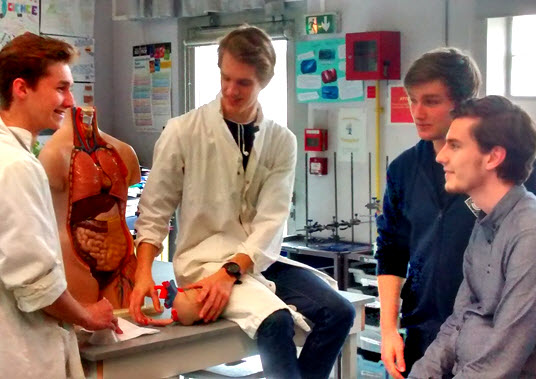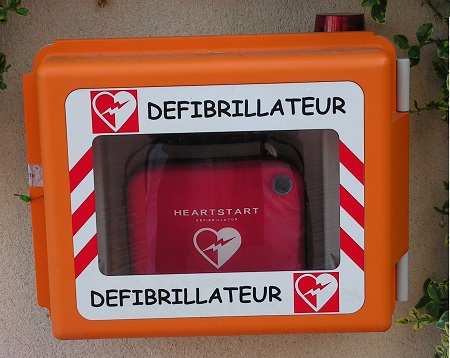Cardiology Role play
 Socratic seminars are frequently used by history teachers to incorporate peer review into a lesson and to encourage the right sort of participation in a discussion. In this lesson the same structure is used to promote realistic illustrations of some of the causes and consequences of a range of heart conditions mentioned in the IB Biology guide. These can be interspersed by teacher demonstrations of a defibrillator and a video of a pacemaker.
Socratic seminars are frequently used by history teachers to incorporate peer review into a lesson and to encourage the right sort of participation in a discussion. In this lesson the same structure is used to promote realistic illustrations of some of the causes and consequences of a range of heart conditions mentioned in the IB Biology guide. These can be interspersed by teacher demonstrations of a defibrillator and a video of a pacemaker.
Lesson Description
Guiding Questions
Does the school have a defibrillator?
Can high blood pressure cause a heart attack?
What are the risk factors of heart disease?
What consequences could there be from taking growth hormone supplements?
Activity 1 - Socratic seminar style mini plays on Hypertension and Thrombosis
This is a great fun way to cover the applications of this topic while maintaining some serious academic content.

To do
Students are first organised into pairs, working with someone they know quite well.
While in pairs students are introduced to the ![]() Socratic seminar peer review rubric which they will use to assess their partner's participation and record their notes about each condition.
Socratic seminar peer review rubric which they will use to assess their partner's participation and record their notes about each condition.
The class forms two groups of about 4 students each with one student from each pair. (Four groups in a big class)
The groups are given a situation card from the ![]() Chez le Cardiologist - situation cards worksheet
Chez le Cardiologist - situation cards worksheet
Each situation has:
- an outline of the heart condition,
- causes of the condition (or risk factors)
- consequences,
- a simple description of the patient
Groups must prepare a short sketch (3 minutes max.), including 3 props from the biology lab.
The sketch will be performed to the class in 10 minutes time.
When a group is not "performing" they use the ![]() Socratic seminar peer review rubric to assess the participation of their partner, and to identify the details of the medical condition, the causes and the consequences.
Socratic seminar peer review rubric to assess the participation of their partner, and to identify the details of the medical condition, the causes and the consequences.
Click the eye icon to display the situation cards. There is an ECG trace, a blood pressure test result and a pacemaker on this ![]() Socratic seminar extra props sheet.
Socratic seminar extra props sheet.
Activity 2 - Defibrillators (AED - automatic external defibrillator)
Watch the short video clip below from a training program.
If possible get a qualified first-aider to visit the lesson and describe how to use the defibrillator in your school.
Questions
1. What is an AED?
...............................................................................................................................................................................
2. What do they do when connected to the patient?
...............................................................................................................................................................................
3. What important telephone call should you make first if you are in a situation where you might use an AED?
...............................................................................................................................................................................
4. What verbal instructions are given by the AED?
...............................................................................................................................................................................
5. When should you use a defribulator?
...............................................................................................................................................................................
6. Why do you need to be aware of the 'good samaritan' laws in your local area?
...............................................................................................................................................................................
Activity 3 - Artificial pacemakers
Watch this short explanation of how a pacemaker works then answer the questions below.
Questions
1. What is a pacemaker?
...............................................................................................................................................................................
2. Which part(s) of the heart is a pacemaker connected to?
...............................................................................................................................................................................
3. What heart beat problem can a pacemaker rectify?
...............................................................................................................................................................................
4. Explain how the pacemaker affects the SA node and the AV node in the heart?
...............................................................................................................................................................................
Teacher's notes
The easiest way to run this lesson will depend how many students are in the class.
For a class of 6-10 students two groups will work well. Students can work in pairs, if there is an odd number the teacher can participate in the review.
In classes larger than 10 students then four groups will be better. Each group could perform one role play, and everyone stays together, or the class can be split into two and the groups perform two senarios each, but only to the other group.
Some students may work more seriously if the senarios are recorded on film.
The peer review can be used for assessment, by the teacher.
The two short videos with questions in activities 2 & 3 are intended for the whole class to watch and then to answer the questions. This could be useful to return the focus of the lesson to serious biology if role play's get a bit frivolous, or to fill in a gap while another group gets their props ready.
The answers for the questions are given in the two video clips and the senario cards, so there are no model answers for this lesson.
If you are not sure about 'role play' I suggest you try it once with an open mind and review the effectiveness with reference to the student's memory of the details in the next lesson. I was pleasantly surprised. If it doesn't work out, then the senario cards could be used for an individual written task.
.

 IB Docs (2) Team
IB Docs (2) Team
